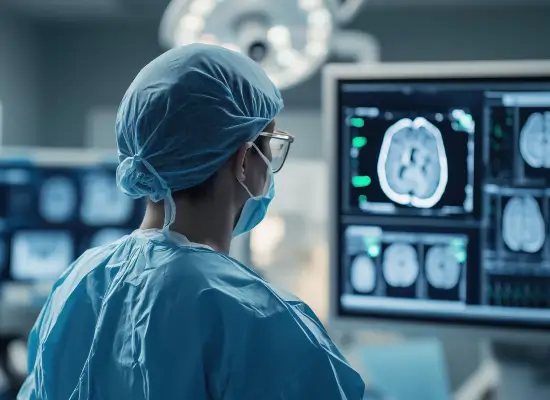DBS is adjustable and reversible. However, it does not cure the underlying health condition. It can help manage the symptoms and improve quality of life, but it does not cure the condition.

Synopsis
Deep Brain Stimulation (DBS) is a highly advanced surgical procedure used to treat various neurological conditions. This procedure is commonly performed on patients with Parkinson’s disease, epilepsy, dystonia, and certain essential tremors.
DBS is generally a minimally invasive technique that can help reduce symptoms, improve motor function, and enhance overall quality of life. Choose Gleneagles Hospitals to ensure the best results for your DBS surgery, with expert neurologists, cutting-edge technology, and personalised treatment plans tailored to every patient.
Introduction
The human brain is a complex network of neurons that regulates all aspects of our body and behaviour. Neurological illnesses that disturb brain function can have a significant influence on a person's quality of life. While drugs and traditional therapies can bring comfort, they are not always successful. This is when Deep Brain Stimulation (DBS) comes into play. DBS is a cutting-edge therapeutic approach that offers fresh hope to people suffering from mobility and psychological problems.
We will delve into the science of DBS, including its mechanism, medicinal uses, advantages, dangers, and post-operative care. We will also discuss why Gleneagles Hospital is a trusted name for DBS stimulation.
What is DBS Surgery?
DBS, or Deep Brain Stimulation surgery, is the surgical procedure for treating multiple neurological and psychiatric disorders. During DBS surgery, electrodes are implanted in the brain, which sends electrical signals to control the aberrant activity of the brain. The impulses generated by the electrodes are regulated by a pacemaker-like device, also known as a neurostimulator, that is generally inserted beneath the skin in the chest.
Who Needs a DBS Surgery?
There is a specific criterion which decides who would need a DBS surgery, but it is typically recommended for patients whose symptoms are not controlled with medication and any other therapy treatment. Patients with movement disorders such as Parkinson's disease or essential tremor are usually the right fit for a DBS surgery. Moreover, it can also help people with epilepsy, dystonia, and some psychiatric illnesses like obsessive-compulsive disorder. However, it is crucial to note that the patient should not have any severe cognitive or psychiatric disorders and should be healthy overall to undergo a surgical procedure.
Your health matters – get expert advice today.
Step-by-Step Procedure Involved in DBS Surgery
The DBS technique consists of multiple steps which are to be performed in the right order to ensure successful outcomes and minimal discomfort for the patients. Let us now discuss each step in detail.
- Pre-Surgical Evaluation: Before initiating the procedure, your doctor will perform a detailed analysis of your medical condition. A comprehensive assessment will be done with various medical imaging tests like MRI and CT scans. Neurological and psychiatric evaluations are done to check the readiness of the patient for a DBS surgery.
- Stereotactic Frame Placement: Once all the assessments are done, the pre-procedure steps begin. This starts by putting a frame on the patient’s head to stabilise its movement during the surgery. Patients with a movement disorder have a shaky head; therefore, a frame is necessary to ensure precision in targeting brain regions.
- Brain Mapping: The next thing is to map out the brain. For this, the doctors use MRI or CT scans that guide the surgeon to the precise target area of the brain. Microelectrode recording is used to identify optimal brain regions.
- Electrode Implantation: Once the brain mapping is done, electrodes are carefully implanted in targeted brain regions. Patients might remain awake during this to provide feedback on symptom improvement and discomfort.
- Neurostimulator Placement: After implanting the electrodes, a separate surgery is performed to implant the pulse generator or the neurostimulator under the skin in the chest. Leads or extension wires are used to connect the electrodes to the neurostimulator.
- Device Programming: After successfully implanting all the devices, once the patient recovers, the device programming is done to deliver optimal stimulation. Multiple sessions might be required to fine-tune the device settings to relieve the patient's symptoms.

Preparations for a DBS Surgery
Preparing for DBS surgery is a multidimensional process. The patient should be prepared not only medically but emotionally and psychologically as well. It is crucial to remember that you will undergo a thorough medical evaluation before the surgery begins; assessments will be done to determine your suitability for the surgery. Some medication adjustments are to be made, which include limiting the intake of some medications that are taken for blood thinning.
Patients should adhere to all the pre-surgical instructions provided by the healthcare provider. For detailed instructions on fasting, medication, and other preparations it is advised to consult your surgeon beforehand. The family members should also ensure that emotional support is provided to the patient, which they would need the most during their treatment and when surgery is performed. After the surgery, it is advised that the patient be prepared to travel back home, as extra care would be required after the implantation.
Post-Surgery Recovery and Rehabilitation
Recovery is an essential aspect of DBS surgery. Every patient has their own recovery journey and healing journey. A structured rehabilitation plan will help ensure a smooth recovery and optimal outcomes.
- Immediate Post-Surgery - Most patients generally require a few days of hospitalisation after a DBS surgery. This stay is primarily crucial to manage the pain and ensure that the patient experiences no discomfort from the implanted devices. Patients need to be monitored until the condition is stable. Managing pain and keeping an eye out for any post-surgery complications are key components of a seamless recovery.
- Device Activation and Programming - A few weeks after surgery, as the patient starts to recover gradually, the DBS device will be activated. Multiple sessions would be required to fine-tune the devices and make the settings according to the patient's needs. It might, however, take weeks or even months for the patient to fully adjust to the DBS devices and get used to them.
- Rehabilitation - Physical therapy and other rehabilitation techniques may be required to help patients recover fully, resume normal activities and get back to work.
Risks and Challenges
While a DBS surgery is highly beneficial for patients with movement disorders, some minor risks and challenges should be considered to ensure an untroubled procedure and a faster recovery. Some of them include:
- Infections - A DBS surgery might have the risk of infections if not performed under proper sanitisation techniques. The infections usually occur at the implantation site or along the electrode pathway.
- Bleeding - Since the surgery is invasive, there are possibilities of bleeding in the brain, which can lead to stroke-like symptoms. This also increases the risks of other problems like surgery infection, haemorrhage, and stroke.
- Hardware Malfunction - If the implanted devices have an issue, they can malfunction and require replacement. Issues such as battery failure or wire displacement can happen. Device-related problems, such as lead migration or hardware failure, are serious and require further medical intervention.
- Neurological Side Effects - A DBS surgery might cause some neurological side effects in some cases. Mood swings, confusion, and cognitive changes are experienced by some patients. Others might experience headaches, disorientation, and mood changes.
- Pain and Discomfort - Minor pain and discomfort are common in patients who have undergone DBS surgery. However, if the pain is persistent at the implant site or along electrode paths, consider visiting your surgeon to get your implant checked.
- Anesthesia Risks - Complications related to anaesthesia can occur in some patients during surgery. In rare cases, patients can become allergic to the anaesthesia, resulting in infections.
Conclusion
Deep Brain Stimulation has revolutionised the management and treatment of neurological and psychiatric disorders. It not only offers patients a renewed sense of hope for relieving their symptoms but also provides a more long-term solution for their problem. While the procedure might involve certain risks, the benefits it provides to the patients outweigh them, making it a viable option. Gleneagles Hospital has provided world-class DBS treatment over the years and continues to do so. The neurosurgeons ensure expert care and long-term patient support for every individual who consults them.
If you are looking for a credible option for your DBS surgery, then Gleneagles is undoubtedly the best hospital you can visit. Consult with the doctors today and get a personalised treatment tailored to your problems.
Dr Naveen M A
HOD & Sr Consultant - Minimal Access Brain and Spine Surgery
MBBS, MS, MCh (Neuro), FMAS, FMISS (Seoul), FASS (USA), Fellow Skull base Endoscopy (USA)
Dr Karthik Y
Consultant Neuro Surgeon
MS, Mch, Neurosurgery, Fellowship in Neuro Endoscopy, Minimal Invasive Neurosurgeon
Frequently Asked Questions
The cost of a DBS surgery would vary based on hospital facilities, surgeon expertise, and post-surgical care. Patients are advised to consult hospitals for an accurate estimate of the overall procedure cost.
Patients with movement disorders or psychiatric conditions that are not responding to medication are the ideal candidates for a DBS surgery. However, an in-depth evaluation by a neurologist is necessary.
Many insurance providers offer partial or full coverage for DBS procedures. It is, however, best to check with the hospital’s finance department for a detailed overview.
The time that an individual would take to recover from a DBS surgery depends on the condition to be treated. Typically, initial recovery takes around a few weeks but patients might take some more time to get used to the stimulator and optimise the setting according to their needs.





















